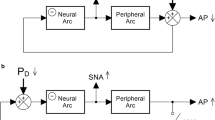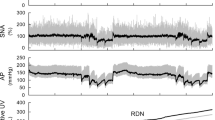Summary
CSF outflow resistance was studied in cats using the lumbar infusion tests. Different infusion rates were applied from 0.012 to 1.8 ml/min. ICP level obtained during infusions varied from 8.9 ± 3.0 to 144.0 ± 25.7 mmHg. The calculated resistance (R) values were within 75.2 ± 14.4 to 255.6 ± 71.2 mm Hg/ml/min.
The relation between ICP and R are characterized by a curve which can be divided into three parts. First R rises until an ICP level of about 20 mmHg is reached, then R decreases fast until the ICP value is about 50 mmHg, a further drop is much slower and the ICP/ R curve becomes almost parallel to the ICP axis. The possible reasons for the ICP dependent changes of R as well as the clinical importance of the results obtained are discussed.
Similar content being viewed by others
References
Börgesen SE (1984) Conductance to outflow of CSF in normal pressure hydrocephalus. Acta Neurochir (Wien) 71: 1–45
Börgesen SE, Westergaard L, Gjerris F (1981) Isotope cisternography and conductance to outflow of CSF in normal pressure hydrocephalus. Acta Neurochir (Wien) 57: 67–73
Butler AB, van Landingham KE, McComb JG (1983) Pressure-facilitated CSF flow across the arachnoid membrane. In: Ishii S,et al (eds) Intracranial pressure V. Springer, Berlin Heidelberg New York, pp 598–604
Butler AB (1984) Correlated physiologic and structural studies of CSF absorption. In: Shapiro Ket al (eds) Hydrocephalus. Raven Press, New York, pp 41–57
Cserr HF (1971) Physiology of the choroid plexus. Physiol Rev 51: 273–311
Czernicki Z, Szewczykowski J, Kunicki A, Sliwka S, Korsak-Sliwka J, Pawlowski G, Dziduszko J, Mempel E, Jurkiewicz J, Augustyniak B (1984) Computerized test II. Clinical application. Neurol Neurochir Pol 18: 561–565
Dacey RG, Welsh JE, Scheid WM, Winn HR, Sande MA, Jane JA (1980) Bacterial meningitis: changes in cerebrospinal fluid outflow resistance. In: Shulman Ket al (eds) Intracranial pressure IV. Springer, Berlin Heidelberg New York, pp 350–353
Davson H, Hollingsworth G, Segal MB (1970) The mechanism of drainage of the cerebrospinal fluid. Brain 93: 665–678
Ekstedt J (1975) CSF hydrodynamics studied by means of constant pressure infusion technique. In: Lundberg Net al (eds) Intracranial pressure II. Springer, New York Heidelberg Berlin, pp 35–41
Gjerris F, Börgesen SE, Sörensen PS, Boesen F, Schmidt K, Harmsen A, Lester J (1987) Resistance to cerebrospinal fluid outflow and intracranial pressure in patients with hydrocephalus after subarachnoid haemorrhage. Acta Neurochir (Wien) 88: 79–86
Huckman MS (1981) Normal pressure hydrocephalus, evaluation of diagnostic and prognostic tests. Am J Neuroradiol 2: 383–395
Hussey F, Schanzer B, Katzman R (1970) A simple constant infusion manometric test for measurement of CSF absorption. II Clinical studies. Neurology 20: 665–680
Johnson RN, Mann JD (1984) Integrated quantitative experimental analyses of the ICP control system. In: Shapiro Ket al (eds) Hydrocephalus. Raven Press, New York, pp 179–192
Katzman R, Hussey F (1970) A simple constant infusion manometric test for measurement of CSF absorption. I. Rationale and method. Neurology 20: 534–544
van Landingham KE, Maffeo ChJ, Adams JM, Butler AB (1983) CSF outflow resistance: effects of transvillus pressure gradients and CSF production. In: Ishii Set al (eds) Intracranial pressure V. Springer, Berlin Heidelberg New York, pp 605–610
Maksymowicz W, Czosnyka M, Koszewski W, Szymanska A, Traczewski W (1989) The role of cerebrospinal compensatory parameters in the estimation of functioning of implanted shunt system in patients with communicating hydrocephalus (preliminary report). Acta Neurochir (Wien) 101: 112–116
Mann JD, Butler A, Johnson RN, Bass NH (1979) Clearance of macromolecular and particulated substances from the cerebrospinal fluid system of the rat. J Neurosurg 50: 343–348
McComb J (1983) Recent research into the nature of cerebrospinal fluid formation and absorption. J Neurosurg 59: 369–383
McComb J, Hyman S, Weiss MH (1984) Lymphatic drainage of cerebrospinal fluid in the cat. In: Shapiro Ket al (eds) Hydrocephalus. Raven Press, New York, pp 83–89
Philippon J, George B, Levante A, Thurel C, Visot A, Cophignan J (1976) Subarachnoid infusion test. Its value in the prognosis of shunted normal pressure hydrocephalus. In: Beks JWFet al (eds) Intracranial pressure III. Springer, Berlin Heidelberg New York, pp 193–198
Portnoy HD, Croissant PD (1976) A practical method for measuring hydrodynamics of cerebrospinal fluid. Surg Neurol 5: 273–277
Povlishock JT, Levine JE (1983) Cerebrospinal fluid absorption. In: Kapp JPet al (eds) The cerebral venous system and its disorders. Grune and Stratton, Orlando, pp 251–274
Shapiro K, Marmarou A, Conway F (1983) Comparison of bolus and constant infusion techniques for determining the resistance of the absorption of CSF. In: Ishi Set al (eds) Intracranial pressure V. Springer, Berlin Heidelberg New York, pp 286–290
Stevenaert A, Godin D, Depresseux JC (1976) Ventriculolumbar perfusion in adult communicating hydrocephalus. In: Beks JWFet al (eds) Intracranial pressure III. Springer, Berlin Heidelberg New York, pp 186–192
Sullivan HG, Miller JD, Griffith RL, Engr D, Carter W, Rucker S (1979) Bolus versus steady-state infusion for determination of CSF outflow resistance. Ann Neurol 5: 228–238
Sullivan HG, Seale JR, Beveridge WD, Alien MB, Flanigin HF (1982) Effect of pressure on cerebrospinal fluid absorption in cats, baboons and human: comparison of the linear and logarithmic models. Neurosurgery 10: 210–223
Sullivan HG, Griffith RL, Miller JD (1980) Comparison of CSF outflow resistance determined by bolus and steady state techniques. In: Shulmann Ket al (eds) Intracranial pressure IV. Springer, Berlin Heidelberg New York, pp 460–461
Sliwka S (1980) Clinical method of intracranial dynamic parameters investigation. Doctor thesis. Medical Research Centre, Polish Academy of Sciences, Warsaw
Sliwka S, Pawłowski G, Korsak-Sliwka J, Szewczykowski J, Czernicki Z (1984) Computerized infusion test. I. Method. Neurol Neurochir Pol 18: 553–560
Tripathi RC (1974) Tracing the bulk outflow rout of cerebrospinal fluid by transmission and scanning electron microscopy. Brain Res 80: 503–506
Tychmanowicz K, Uchman G (1990) Cerebral angiography of a cat. Lab Anim 27: 83–92
Author information
Authors and Affiliations
Rights and permissions
About this article
Cite this article
Tychmanowicz, K., Czernicki, Z., Pawłowski, G. et al. ICP Dependent changes of CSF outflow resistance. Acta neurochir 117, 44–47 (1992). https://doi.org/10.1007/BF01400634
Issue Date:
DOI: https://doi.org/10.1007/BF01400634




